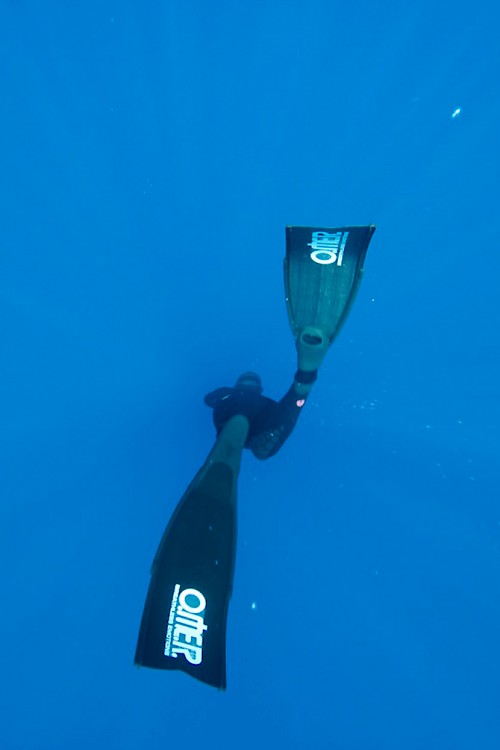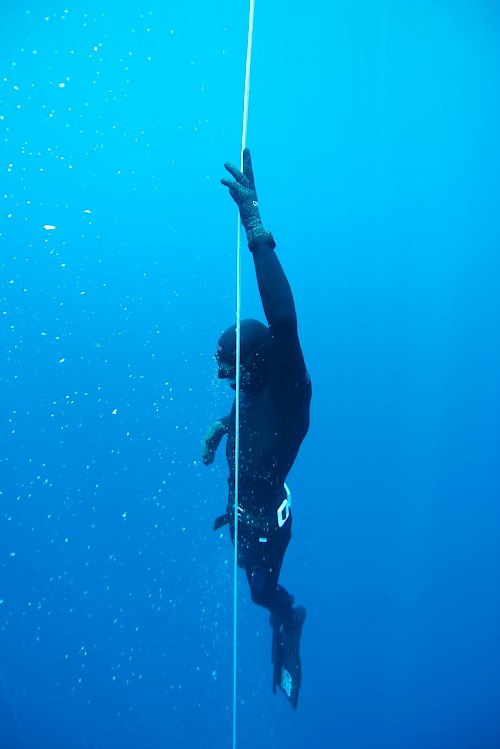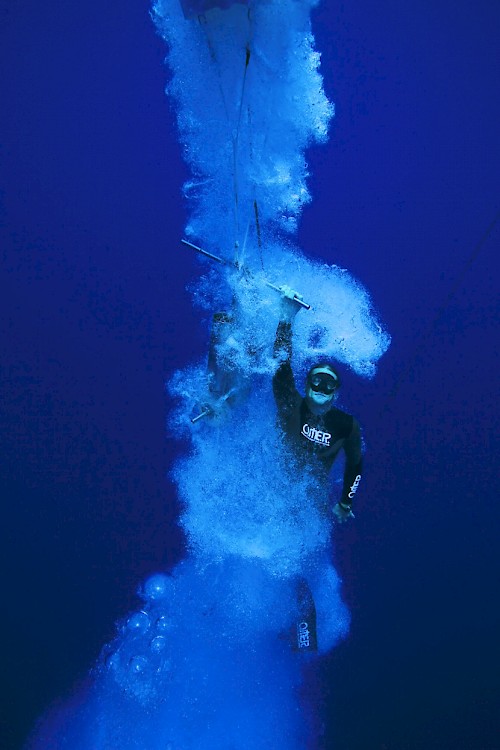Profile
Umberto Pelizzari
PROFILE
UMBERTO PELIZZARI was born on the 28th August 1965 in Busto Arsizio, in the province of Varese. He is 1.89 metres tall and weighs 84 kg, and his lung capacity is 7.9 litres. By the age of 5 he can already swim perfectly and by the age of 17 he already had 11 seasons of swimming behind him at a professional level. In 1984 he begins to dedicate himself to apnea. He reaches his first world record in 1988 when, with 5'33", he establishes the record in static apnea. Having become a member of the NO LIMITS SECTOR Team, on 19th May 1990 - in the public pool of Busto Arsizio - he breaks the world record of static apnea, beating the previous record of 5'50" established by the French Philippe Goasse with 6'03". On the 12th of July, 1990, he earns a degree in Information Science at the University of Milan. In the meantime he has started training, with the goal of breaking the world record on the Isle of Elba. On the 10th of November, on the same year, in Porto Azzurro, Umberto amazes everybody by reaching a new world record of immersion apnea in constant weight, reaching a depth of 65 metres even though he has just started to participate in this difficult discipline. He beat Pipin Ferreras' record by 3 metres which had been established only two months earlier. In Hawaii, on the 9th July 1991, he reclaims the record in static apnea with 7'02"88, smashing the old record of 6'40" held by the French Michael Bader. In this discipline, his best performance is now 8 minutes. In 1995, during a medical test held by Prof. Piergiorgio Data, at the University of Underwater Medicine in Chieti, after 8 minutes breathing pure oxygen, Umberto Pelizzari holds his breath for 19'56''. September 1991, on the Isle of Elba, he conquers all the records of immersion apnea. The 3rd of October sees him descend in constant weight to a depth of 67 metres, improving his previous record by 2 metres. On the 22nd of October, Umberto reaches a world record of immersion apnea in variable weight, reaching -95 metres, improving the record established by Pipin in September 1990 in Milazzo, by 3 metres. On the 26th of October, he obtains his third world record in a month, beating the absolute record in immersion apnea with -118 metres (but in 1992 this record is broken with -120 metres by a Cuban rival). On September 17th, 1992, in Ustica, Umberto reclaims the world record of immersion apnea in constant weight with -70 metres, which he lost to Pipin on the 27th of May. On the 11th of October 1993, off-shore of Montecristo, he establishes a new record in "no limits", variable weight, descending to a depth of 123 metres. Umberto holds this record only until the 14th of the next month, when in Grand Bahama, Pipin improves on it with -125 metres. On July 24th 1994, at Cala Gonone-Dorgali, in Sardegna, Umberto reaches his new world record in immersion in apnea in the Variable Ballast discipline descending to a depth of 101 metres.
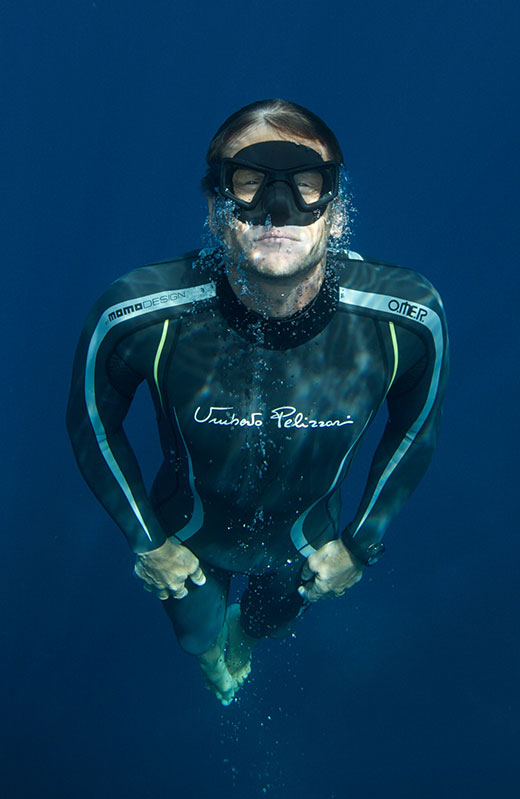
In July 1995, at Villasimius in Sardegna, he claims two new world records: -72 metres in constant weight (16th July) and -105 metres in variable weight (only to see Gianluca Genoni break his record by only a metre on the 17th of August 1996).
In 1996, again in Villasimius, he once again achieves a double world record: on the 9th of September is with -110 metres, he takes the world record again in variable weight and on the 16th of the same month, with -131 metres, he takes away Pipin's record in "No limits", variable weight. On the 13th of September 1997, at Porto Venere in Liguria, he again conquers the world record in constant weight with a depth of 75 metres, beating the Cuban Alessandro Ravelo at -73 metres. On the 20th of September against the same Cuban competitor, Umberto wins the records in variable weight, descending to 115 metres. In 1999, Umberto Pelizzari once again holds all records for freediving in the world. On the 18th of October '99, during the Genoa Boat Show, four miles away from the Cape of Portofino, Umberto establishes a new world record in the discipline of Constant Weight, with a dive of 80 meters. This improves the record by 4 meters, set by the Cuban Alejandro Ravelo in August 1998 in Sicily. On the 24th of October 1999, with the technical support of Nave Anteo (a 97 meters long boat of the Italian Navy), Umberto makes history with a dive to a depth which was considered impossible for man by underwater medicine. He descends to 150 meters in the discipline of "No limits", variable weight. After a dive of 2'57", he is again the Man with the Deepest Dive in the World. In 2000, Umberto Pelizzari is involved in the making of the film OceanMen, produced by IMAX (2D), which tells the story of two great free-divers: Umberto and Pipin. In October 2001, the Italian National Team comprising Umberto Pelizzari, Davide Carrera and Gaspare Battaglia won the gold medal at the Freediving World Championship by Team, held in the Club Med Resort in Ibiza. Once again in October, Mursia (Biblioteca del Mare) published the first free-diving illustrated manual, written by Umberto and Stefano Tovaglieri. 2001 is a magical year for Umberto; on the 3rd of November in the waters of Capri, he established a new free-diving World Record in Variable Weight. The athlete dived to 131 meters and back in 2'44", beating Genoni's record by 5 meters. This is a great performance, considering that in 1996, Pelizzari ascended to the surface from the depth of 131 meters with balloons during the No Limits World Record. Umberto dedicated this record to everyone who has supported him these past 11 years and ... in glory he retires from official individual competitions. At this moment Umberto is working as a journalist and reporter in television programs about science spreading and ocean environments. He created Apnea Academy, a school for freediving, researching, teaching and spreading to world-wide level. The Ministry of the Interior nominated him as a component of teaching group for courses of National Fire Department scuba divers. Since 2006 he's worked as a teacher in Superior Normal School S.Anna in Pisa, at the second level Master of Underwater and Iperbaric Medicine. Since September 2013, he's been a teacher in the PHD of Underwater and Hiperbaric Medicine at the University of Palermo
CONCEPTION
From the depth of 100 metres and more, headlong in the abyss, the heartbeat gets slower, the body disappears, and all the feelings take a new form. The only thing that remains in us is the soul. We take a long jump into the soul, which seems to absorb the universe. Every time I ascend, I am making a choice: it is me who is re-discovering myself in my human dimensions, metre by metre, to come up to see the light again. It often happens that I am asked what is there to see deep down in the sea? Maybe the only possible answer is that one does not descend this way to look around, but to look into Himself. In the deep I look for myself. This is a mystical experience bordering on the divine. So deep down, I am immensely alone but inside it feels as if all humanity is with me. It is by being human that I surpass the limits we set for ourselves and diving makes us one with the sea and its surroundings. It is here that I become one with the sea and discover my true self.
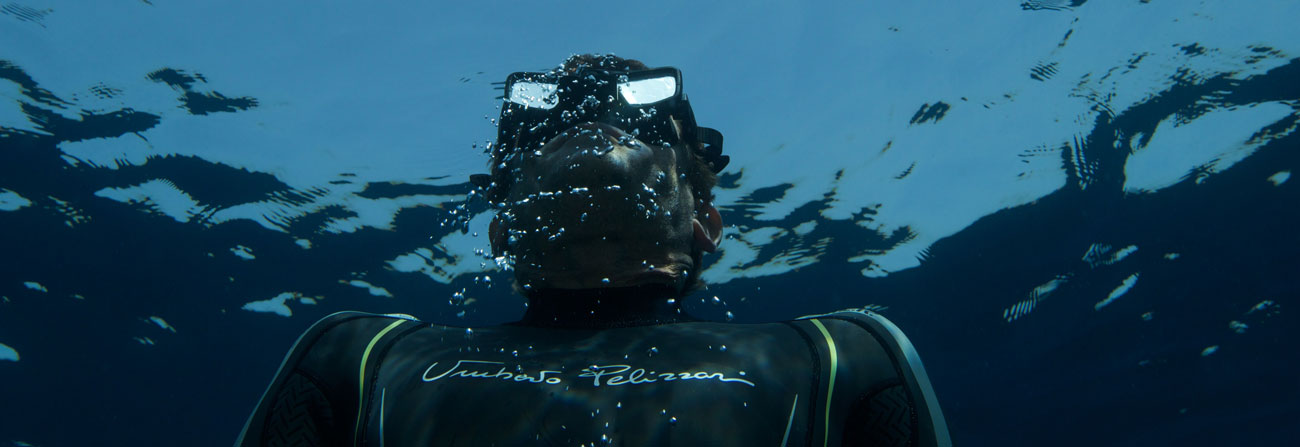
The scuba diver dives to look around, the freediver dives to look inside.
When I am in the blue, I try to see and perceive as far as possible. With my gaze, I would like to go farther, though I do not know where. It would be enough for me to see my destination, but I cannot. It seems that the sunbeams want to help me: they break the surface and penetrate deep into the abyss. They show me the direction, and invite me to follow them.
I can win a challenge with myself or with a competitor, but the sea will win any challenge with man. I do not beat the sea, it is the sea that lets me win.
I become a single entity with the sea. I know that I am a man that needs to breathe but I feel that I don't need to.
My heart beats very slowly: one slow throb every 7 seconds, 8 or 9 beats a minute. My lungs are a little bigger than an apple or a clenched fist.
Coming out of every deep dive, I cross myself. Before the dive, it's in order to ask, after the dive it's in order to thank.
The first breath taken after emerging from the depths of the sea is like the newborn's first breath upon leaving the womb.
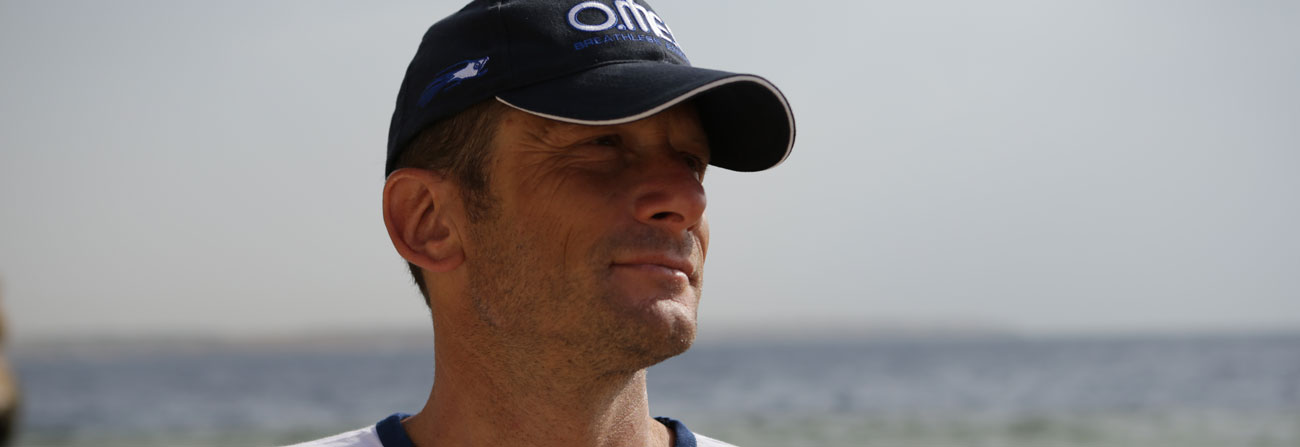
An old Eskimo proverb says: "When a man leaves for a foreign country and abandons his land, he takes his wife and his heart with him, but leaves behind the weapons and laws of his people, in order to accept those of the country where he is going." So it should be in our approach to the sea.. The sea is neither a land to conquer, nor a border to overcome. The sea is a friendly element.
".... I have seen you in the sea today. You did well. I really like the way you dive. I am just an old fisherman, but let me give you a piece of advice. Remember that you can dive into the deep in two ways." As he says this, he picks up a piece of coral and throws it into the sea, then he drops the milk of half a coconut into the water: "Look! The coral and the coconut are now together in the water. But the coral remains coral, while the coconut milk is now sea water: when you dive, do not be as the coral, but as the coconut milk. When you freedive, you must not set yourself against the sea. It shouldn't be you, your body, your skin and the sea; instead every single part of your being must merge with the water.
The dolphins smile because when God created the Earth and populated it, he created the Sea as well, and populated it with fish and mammals. Then he took a big palette to colour all the fish, painting the bigger animals light blue and silver. But when it was the dolphin's turn, God realized that he had run out of colours. So, he said: "I want to make up for what I have done: the dolphin will not have any colour, but he will be the only inhabitant of the sea able to smile."
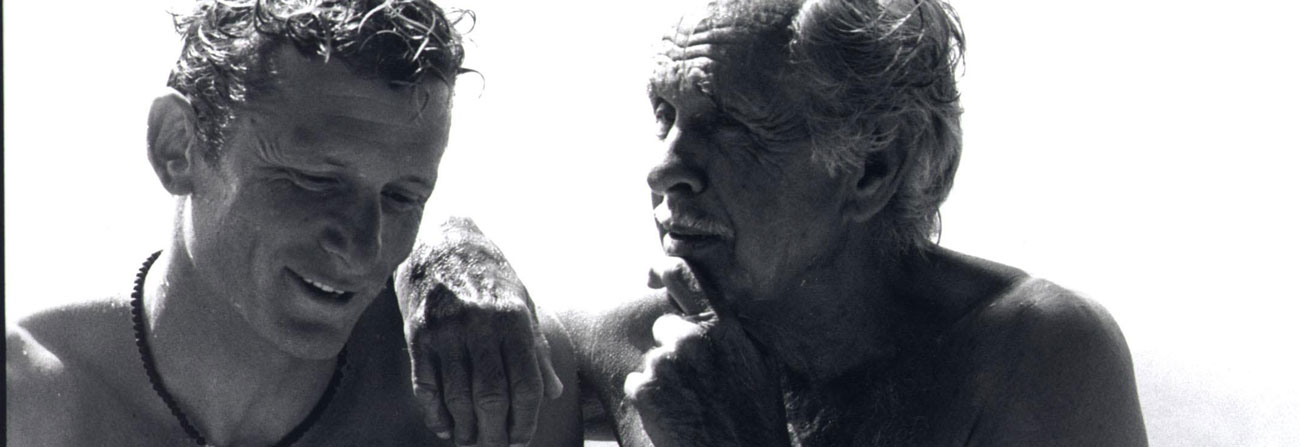
Mayol said to me: "If you want to dive with me, give up your human personality, take off your diver watch. You should not have any other goal but this: every time you dive, and every time you reach the bottom of the sea, you must feel stronger and experience more pleasurable sensations than the previous time, in your last dive. You must go deep into your feelings and, in order to do that, you cannot be concerned with the metres of depth or the seconds in apnea.
Watch the dolphins as much as possible. Follow them, listen to them, imitate them. Learn from them in order to live in the water.
When I dive deep, extraordinary phenomena happen and they have consequences on both a physical and mental level. The water becomes something magical: I know that I'm a man and that I must breathe, but I manage not to feel this need.
In the world of freediving, opposite situations live together. The hard sacrifice and the intense effort of the periods of physical training, in opposition to the pleasure and the emotions of a swim with dolphins or a dive along a coral wall. The determination and the desire to beat a competitor in opposition to the challenge with ourselves. The competition and the apparent lack of competition. Humility and presumption. Relaxation and determination. Joy and thoughtlessness, strong tenacity and implacable perseverance. All of this is Freediving.
I dive into the abyss to see how deep "my sea" is. I freedive to feel new sensations and emotions that I would otherwise never feel. I do not know what pushes me down there and I do not care to know what it is: it is so beautiful that I will always dive, for as long as my body allows.
"... Do you know what you have to do in order to live in the world of mermaids? You have to dive down to the bottom of the sea, very far, so far that the blue no longer exists, where the sky is nothing more than a recollection. And when you are there, in the silence, you stop, and if you decide that you want to die for them and stay with them until the end of time, then the mermaids come to you, to judge the love you are offering them. If it is sincere, if it is pure, then they will welcome you forever…" from the movie The Big Blue.
UMBERTO'S RECORDS
Static freedive |
|||
|---|---|---|---|
|
8 minutes
|
Martinique
|
|
|
Static freedive with oxygen |
|||
|---|---|---|---|
|
19'56''
|
University of Chieti
|
|
|
Constant Weight |
|||
|---|---|---|---|
|
-65 meters
|
Elba Island (TUSCANY)
|
1990
|
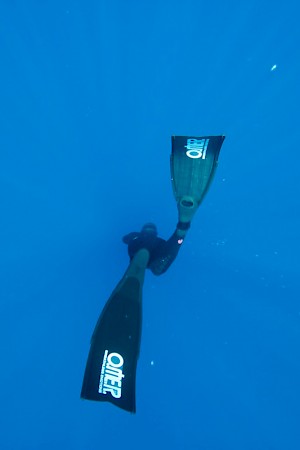 |
|
-67 meters
|
Elba Island (TUSCANY)
|
1991
|
|
|
-70 meters
|
Ustica Island (SICILY)
|
1992
|
|
|
-72 meters
|
Villasimius (SARDINIA)
|
1995
|
|
|
-75 meters
|
Portovenere (LIGURIA)
|
1997
|
|
|
-80 meters
|
Portofino (LIGURIA)
|
1999
|
|
Variable Weight |
|||
|---|---|---|---|
|
-95 meters
|
Elba Island (TUSCANY)
|
1991
|
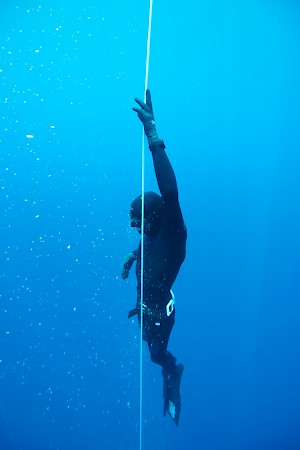 |
|
-101 meters
|
Cala Gonone (SARDINIA)
|
1994
|
|
|
-105 meters
|
Villasimius (SARDINIA)
|
1995
|
|
|
-110 meters
|
Villasimius (SARDINIA)
|
1996
|
|
|
-115 meters
|
Portovenere (LIGURIA)
|
1997
|
|
|
-131 meters
|
Capri Island (CAMPANIA)
|
2001
|
|
No Limits Absolute Variable Weight |
|||
|---|---|---|---|
|
-118 meters
|
Elba Island (TUSCANY)
|
1991
|
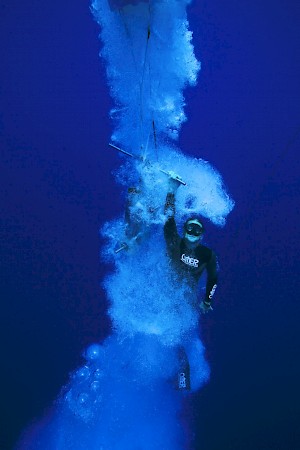 |
|
-123 meters
|
Montecristo Island (TUSCANY)
|
1993
|
|
|
-131 meters
|
Villasimius (SARDINIA)
|
1996
|
|
|
-150 meters
|
Portofino (LIGURIA)
|
1999
|
|
APNEA
CONSTANT WEIGHT
The athlete reaches the maximum depth with the strength of his legs to re-ascend then in the same way without being able to touch the rope of descent.
VARIABLE WEIGHT
The athlete can have lumbers of maximum 30 kg to reach the maximum depth. The lumber is left at the bottom and the athlete comes up on his own without being able to use any kind of help like balloons or other.
"NO LIMITS" VARIABLE WEIGHT
With this speciality one can reach a maximum depth with the help of lumbers, with no limit on their weigh. One can come up with the help of balloons.
